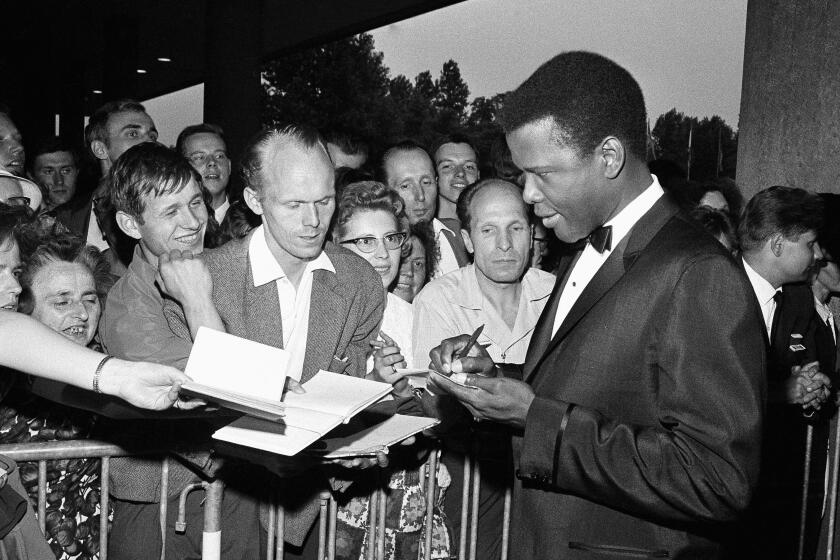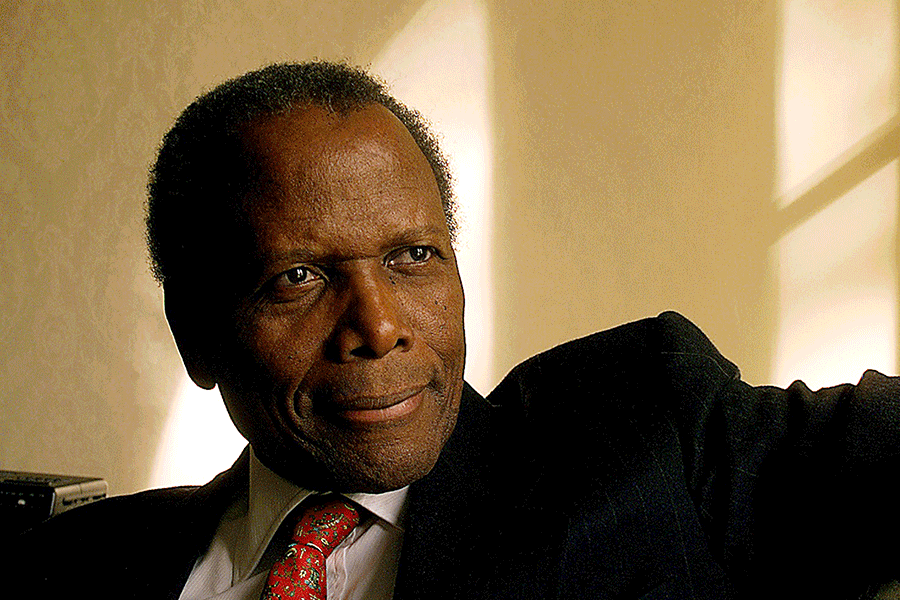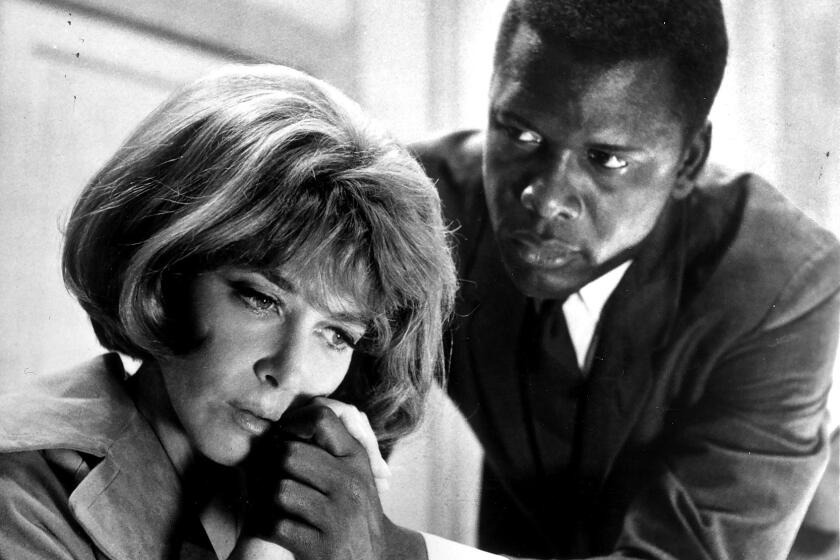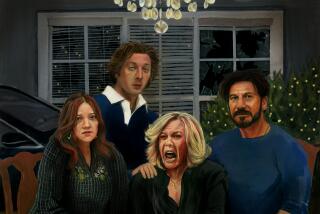‘Guess Who’s Coming to Dinner’ told the story of many families, including mine
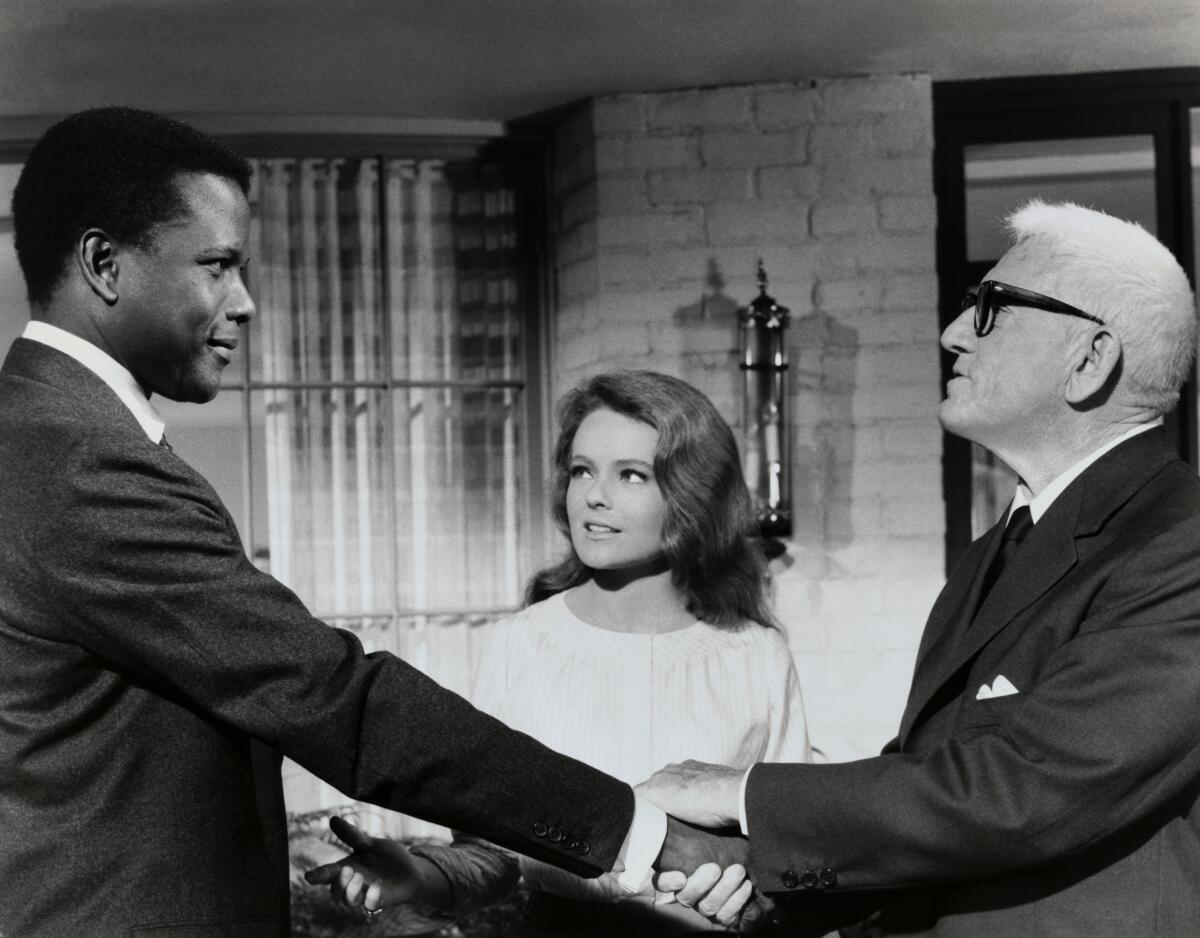
- Share via
Learning that Sidney Poitier had died, I thought first of his performance in “Guess Who’s Coming to Dinner,” not because it was his best film, or even my favorite, but because it told the story of so many families, including mine.
Poitier was an actor-activist in the best sense of the word. Not only was he committed, in word, deed and dollar, to the civil rights movement, but his performances were their own form of activism; Poitier made breaking barriers and rearranging cultural consciousness an art form. Some of this had to do simply with his being one of the few Black actors playing leads in mainstream films for so long, but more important than the roles he took was how he played them.
“He’s so calm and sure of everything,” Katharine Houghton’s Joey tells her mother, Christina Drayton (Katharine Hepburn), in “Guess Who’s Coming to Dinner.” “He doesn’t have any tensions in him, he knows what he believes and what he thinks is right and why and where he’s going.”
She could have been describing Poitier, who brought to every character a clear sense of not only himself, exhibited in whatever way best fit the part, but also in the character’s social and emotional context. Poitier seemed to understand exactly who and where he was, and he granted every man he played that same grace.
Joey, however, is describing Dr. John Prentice, whom Poitier plays in “Guess Who’s Coming to Dinner,” a man of such impeccable bona fides — he is assistant director of the World Health Organization, for heaven’s sake — that the real question is not whether he should be “allowed” to marry Joey but what exactly she brings to the table.
The actor who helped break down Hollywood’s onscreen color barriers before becoming one of the top box-office draws of the 1960s has died at 94.
In 1967, however, the fact that John was Black and Joey was white was enough to act as both obstacle and plot engine, as the couple’s two families attempt to come to terms with their decision to marry. That Joey’s father, Matt Drayton (Spencer Tracy), is a life-long liberal facing at last his own racism, is a side note; the movie is about love and its ability to conquer all, etc.
Viewed in 2022, the film feels dated in precisely the ways you would imagine, from the terminology (“Negro,” “colored man”) to the climax, in which the white patriarch delivers his blessing, and everyone tears up in gratitude. But it remains a movie that resonates with me because something similar happened in my family, with a very different ending.
Right around the time “Guess Who’s Coming to Dinner” came out, my aunt Barbara met Kassim Ismail, the man she would marry two years later. He was a handsome, successful veterinarian and animal sciences expert with an unforgettable laugh. He was also Malaysian. When my aunt brought him home to meet her folks, they loved Kassim — until she told them she was going to marry him. Then my grandfather exploded, in a way that did not end with a change-of-heart benediction.
I was 6 when Barb and Kassim married, too young to understand exactly what was going on but old enough to register my grandfather’s absence from the wedding. And the fact that he subsequently refused to say Barb’s name, or allow my grandmother to talk about her — or, according to my father, to her. At the time I thought what made my grandmother cry and my father spend hours trying to persuade him to accept Barb’s new life was the fact that my aunt and uncle had settled in Malaysia. Then I thought it was because Kassim was Muslim. (We were Irish Catholic.) “No, honey,” my aunt told me later. “It was because he wasn’t white.”
My grandfather was not exactly Spencer Tracy’s liberal judge, but he had raised three children who worked, in different ways, for the civil rights movement, and it shocked me to realize he was acting exactly the way I had been taught was wrong. It was my first encounter with the kind of bigotry I had only seen portrayed on screen.
My grandfather eventually came around, when Barb and Kassim had children, but I thought about the damage he had done to our family every time I watched or came across a reference to “Guess Who’s Coming to Dinner.” Kassim died when I was still young, and as I entered adolescence and adulthood, their relationship became, to me, a pinnacle of romance, with Poitier and Houghton as dreamy stand-ins.
Sidney Poitier, who made history as the first Black man to win an Oscar for lead actor and who starred in ‘Guess Who’s Coming to Dinner,’ has died.
My aunt, as it turns out, does not appreciate the comparison. I called her to see if it was OK to write about her marriage and the film. While she was very sad over Poitier’s passing, she said she didn’t think much of “Guess Who’s Coming to Dinner.” She actually hadn’t seen it until fairly recently — “maybe I unconsciously avoided watching it,” she said — and she was not impressed. Poitier was wonderful, she said, but she hated the character of Joey, who doesn’t seem to have a thought in her head.
“I didn’t agonize over the fact that my father rejected my marriage,” she said. “My dad loved Kassim until I told him we were getting married, and then he turned very ugly. I just thought, ‘That’s your loss’ and walked out. I know it was hard on Mom, but I wanted to be with Kassim.”
This, obviously, makes it all even more romantic. In the film, Poitier’s John says he will not marry Joey without her parents’ approval, because the disruption would hurt her too much. It’s a necessary point — why else would we care what the Draytons think? — but a potentially character-damaging one. Only Poitier could make such an offer seem neither manipulative nor submissive; even viewed in 2022, John’s leaving the decision up to Joey’s parents feels very much in keeping with his character — a man who knows what he wants, what he is willing to do battle with and what he is not.
Watching it the day Poitier’s death was announced, I realized his performance, along with that of Beah Richards as John’s mother, is what has kept the film vital after all these years. Oh, Hepburn and Tracy are wonderful to watch, because they’re always wonderful to watch (and the fact that this is Tracy’s last film makes it even more poignant). But they are acting in a Tracy/Hepburn bubble. I see my aunt’s point about Joey being absurdly wide-eyed and empty-headed, and Roy Glenn, as John’s father, is allowed only to glower and yell.
It’s Poitier who radiates as the mesmerizing center of the story, watchful but certain of himself as everyone else flutters around in various states of shock and fear and prejudice. Poitier gives John an exquisite balance of worldliness and hope: He is not so much allowing the Draytons to make the final decision as forcing them to confront who they really are. He’s the reason “Guess Who’s Coming to Dinner” remains a cinematic touchstone, a shorthand for those who have experienced similar situations and an immediately recognizable influence on contemporary films like “Get Out.”
From ‘A Raisin in the Sun’ to ‘Guess Who’s Coming to Dinner’ to ‘To Sir, With Love,’ here’s where to stream some of Sidney Poitier’s most acclaimed movies.
Yes, the issues the film addressed still, tragically, resonate. The creation of a mixed race/culture couple may no longer be enough to center a film that is not “West Side Story,” but we do not yet live in a time in which Poitier’s watchfulness has become unnecessary.
Few actors are able to not only embody a character but to make him so known, for who he is and what he represents. Few other actors are able to do so much with a stare or a smile, an emotion-choked rant or an active steady silence.
In “Guess Who’s Coming to Dinner,” as in so many other films, Poitier captured all the action and reaction roiling beneath the surface of human interaction. In his hands, action sparked reaction, heat turned into light, and, as with an actual star, all we saw was the shine.
More to Read
The biggest entertainment stories
Get our big stories about Hollywood, film, television, music, arts, culture and more right in your inbox as soon as they publish.
You may occasionally receive promotional content from the Los Angeles Times.
